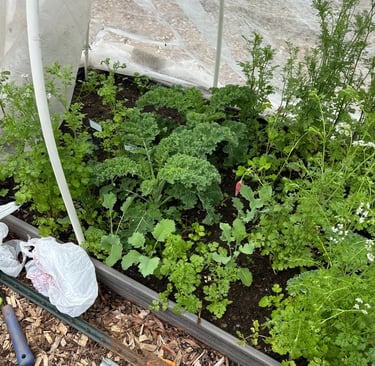Caring for Your Summer Crops: Essential Tips for a Thriving Garden
5/22/20254 min read


The Importance of Proper Watering
Effective watering is crucial for the health and productivity of your summer crops. During the hotter months, plants experience increased evaporation rates, making it essential to provide adequate moisture to ensure their survival and growth. Deep watering, which involves saturating the soil 2-3 times a week, encourages the development of strong root systems. This practice allows roots to grow deeper, reaching check moisture and nutrients that are not available in the upper layers of soil. Strong root growth is vital for plants to withstand drought conditions and absorb essential nutrients efficiently.
The timing of watering sessions is another factor that significantly impacts the well-being of summer crops. Early morning is generally considered the optimal time to water, as it allows for less evaporation compared to midday watering. Additionally, this timing enables plants to absorb the moisture before the heat of the day, reducing stress and enhancing their efficiency in utilizing water. Conversely, watering in the evening can lead to longer moisture retention on leaves, which may promote fungal diseases.
Gardeners must also be aware of the signs of overwatering and underwatering, as both can lead to stress in plants. Symptoms of overwatering include yellowing leaves, wilting, and root rot, while underwatering may manifest as drooping leaves, scorched foliage, or stunted growth. Identifying these issues promptly allows gardeners to adjust their watering practices accordingly, ensuring their summer crops thrive throughout the growing season. A balanced approach to watering is essential for a flourishing garden, facilitating optimal plant health and fruitful harvests.
Mulching Techniques for Moisture and Weed Control
Mulching is a critical practice for maintaining the health and productivity of summer crops. One of the primary benefits of applying mulch is its ability to retain soil moisture, crucial during the warmer months when evaporation rates can be high. A layer of organic materials such as straw, dried leaves, or shredded paper helps create a barrier that reduces water loss from the soil. This is particularly beneficial for crops like tomatoes and peppers that thrive in moist but well-drained soil.
In addition to moisture retention, mulching plays an essential role in controlling weed growth. Weeds compete with summer crops for nutrients and water, which can significantly hinder crop development. By applying a thick layer of mulch, you can suppress the germination of weed seeds. Materials such as straw and wood chips can be particularly effective in creating an environment that discourages weeds from taking root. When choosing your mulching material, consider availability and cost-effectiveness; for instance, shredded paper can be a sustainable option if you have access to it in bulk.
Timing is also a critical factor in the application of mulch. It is advisable to apply mulch after the soil has warmed but before weeds have a chance to establish themselves. Additionally, the type of crop you are growing may influence your mulching technique. For instance, sprawling crops like cucumbers may benefit from a thicker mulch layer that supports their growth pattern, whereas more delicate plants might require a lighter application to avoid suffocation.
In conclusion, effective mulching techniques are vital for moisture conservation and weed management in your summer garden. By selecting the right materials and timing their application appropriately, you can enhance the performance of your crops and support a thriving garden ecosystem.
Pruning and Staking for Healthy Plant Growth
Maintaining the health and productivity of summer crops is vital for ensuring a bountiful harvest. Two essential practices that contribute to the flourishing of these plants are pruning and staking. Proper staking not only provides structural support but also enhances air circulation and light penetration, enabling crops to grow vigorously. For instance, tomatoes, beans, and peppers often require staking to prevent sprawling and potential damage caused by wind or their own weight. Choosing the right type of support, such as cages, trellises, or stakes, is crucial. When staking tomatoes, place the support early in the planting process to avoid disturbing the root system later. Ensure the stake penetrates deep enough to withstand the growing plant's weight without toppling.
Moreover, systematic pruning is instrumental in fostering healthy growth in summer crops, especially for indeterminate tomato varieties. The pruning process involves selectively removing lower leaves and suckers – the shoots that emerge from the joint between the stem and a leaf. By eliminating these potential energy drainers, plants can redirect their resources towards fruit production instead of foliage. It is also beneficial to remove any leaves that are in close proximity to the soil to minimize the risk of soil splash during rain, which can lead to fungal diseases like blight. Regularly inspecting plants for unhealthy branches or diseases also forms a part of effective pruning strategies.
In summary, proper staking and pruning techniques are fundamental to ensuring the health and productivity of summer crops. By providing adequate support through staking and implementing a thoughtful pruning regimen, gardeners can promote healthier plants that are better equipped to thrive during the growing season.
Effective Pest Control Strategies
Managing pests effectively is crucial for the success of your summer garden. One of the most advocated natural pest control methods is the use of neem oil. Derived from the seeds of the neem tree, this organic compound acts as a potent insect repellent and can disrupt the lifecycle of pests, reducing their population significantly. By applying neem oil directly to affected plants, gardeners can deter pests such as aphids, spider mites, and whiteflies without harming beneficial insects when used correctly.
Another valuable option for pest management is insecticidal soap. This solution effectively targets soft-bodied insects, such as aphids and mealybugs, by suffocating them on contact. It is essential to apply insecticidal soap during the early morning or late afternoon to minimize harm to beneficial insects. When using these natural pest control methods, it is important to follow application guidelines to ensure maximum effectiveness while protecting the garden's ecosystem.
Introducing beneficial insects, such as ladybugs and lacewings, can significantly help control pest populations. These natural predators feed on common garden pests, providing an effective and environmentally friendly method to maintain a healthy garden. When introducing these beneficial insects, it is essential to create an inviting environment that promotes their habitation, including a diverse range of flowering plants that attract them.
Moreover, championing companion planting can provide additional layers of protection against pests. Pairing flowers like marigolds, which are known to repel nematodes and aphids, with herbs like basil that deter flies and mosquitoes, can enhance plant health. Nasturtiums serve as a trap crop; they lure pests away from more valuable crops, reducing damage overall. By thoughtfully integrating these pest control strategies into your summer gardening practices, you can cultivate a thriving garden while minimizing reliance on chemical pesticides.
Grow
Cultivating wellness through gardening and sustainability.
Email Us:
© 2025. Healing IN Garden & Farm LLC. All rights reserved.
Created by askdolo.com
